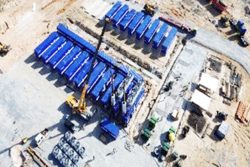With a bigger budget, the Region Six administration expects to deliver major investments this year, including in education.
Regional officials told a news conference last Friday that the $6,462,560,000 budget for 2018 represents an increase of $362 million over last year’s budget. The region has been allocated $5,918,360,000 for its current programme and just over $544 million for its capital programme.
Regional Chairman of Region Six David Armogan noted that in 2017, the region was given a total of $6.1 billion, of which it spent some 99.16%. “I think it is a commendable performance, especially when we take into account that [at] the mid-year we were just over 30%. So for the second half of the year we were able to push ahead and complete all the works we had allocated for 2017,” he said.
He then explained, that the current budget for 2017 was $5,587,000,000, of which 99.08% was spent. “The money that would have remained based on the voted provisions would be salary, wages and electricity and water charges,” said Armogan. “We have almost 2, 175 workers within the region, our wages and salaries is almost 50% of our budget,” he added.
Armogan further noted that for 2017, the region was allocated $513 million under its capital budget, of which over $512 million was spent. “Our overall performance for 2017 would have reached our expectations because at the beginning of the year we did say to you, that we would have tried as much as possible to spend 100% of the voted provision. This is always our aim because we believe that every dollar that is spent in the region is to improve the lives of our citizens within the region,” he said.
Armogan highlighted that for education delivery under the region’s current programme for 2018, $3,129,258,000 has been allocated, while under its capital programme over $109 million has been allocated. “This takes up over 48% of the regional budget and that shows the emphasis we are putting on education within the region,” he said.
For health services under the current programme, he noted that the region was given $1,656,179,000 and over $162 million for its capital programme.
Additionally, the chairman related that under the capital programme the region will be spending $109 million for major excavation works, which includes work on several sluices; $107 million on roads; $85.5 million on buildings, furniture and equipment for the education sector; $33 million on bridges; and $24 million for drainage and irrigation.
Armogan said one of the sluices that the region will be doing is the Pepper Sluice in Cumberland Village, East Canje, which would have been operated by GuySuCo over the years. He noted that because of the poor cash flow, the sluice has been neglected to the extent that it is not working anymore. “So we have to do [it] because it is important for drainage within the Canefield – Cumberland [villages] area. That sluice is very, very important for drainage and so we will do that sluice during this year and that will improve the drainage in a big way,” he said.
The chairman went on to relate that under the capital programme, the region will be spending $132 million on buildings, of which $82 million will be spent on a Maternity Unit at the New Amsterdam Public Hospital.
Meanwhile, Regional Executive Officer of Region Six Kim Stephens, in giving a breakdown of the budget, noted that from the capital budget, the region is expected to undertake the excavation and dredging of the Number 66 Village, Corentyne creek at the cost of some $12.7 million. According to Stephens, some 250 rods will be dug using pontoons in an effort to “allow the free flow of water within the area which will benefit over 200 fishermen.”
Adding to this, construction of the roadway at Third Street, Lesbeholden South, Black Bush Polder, at the cost of $13 million, is also planned.
According to Stephens, in terms of investment in the education sector within the region, the Number 36 Primary School will be completed to benefit some 120 students. Additionally, she said other schools will also see rehabilitation works. These include Skeldon Primary, which will be rehabilitated at a cost of $15 million for the benefit of 580 students, and the Tutorial Secondary School, where a sanitary block will be constructed to benefit “special needs” students. “We are going to install ramps, toilets and showers there too,” she further noted.
The Department of Education will also be extended for the installation of a computer room, which will be done at a cost of $7 million.
Stephens then stressed that the region will also be investing in furniture for the education sector.
In the health sector, Stephens noted plans for the construction of a theatre at the Skeldon Hospital, which will be done at a cost of $16.5 million to benefit some 3,200 persons. She also said that the construction of the doctors’ quarters at the New Amsterdam Hospital will be done to benefit both Guyanese and Cuban doctors.
She also mentioned plans to purchase furniture and equipment, including ward beds, fetal monitors, ventilators, and cardiac monitors, at the cost of $30 million, to strengthen the services provided at the health facilities throughout the region.









